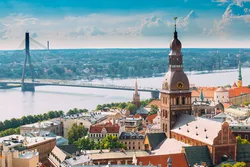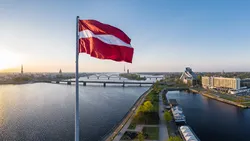See all articles relating to: Latvia

Latvia, a small Baltic nation in Northern Europe. Inhabited since at least 9000 BC, the region's first known inhabitants were the Balts. Over the centuries, Latvia has been under the control of various powers, including the Livonian Order in the 13th century, Poland-Lithuania in the 16th century, and later Sweden and Russia. It was only in 1918 that Latvia declared independence following the end of World War I, but the country was occupied again by the Soviet Union and Nazi Germany during World War II. Throughout its history, Latvia has been shaped by prominent figures such as Jānis Čakste, the first President of Latvia (1922-1927); Kārlis Ulmanis, who led the country through an authoritarian regime during the 1930s; and Vaira Vīķe-Freiberga, the first female President of Latvia who served from 1999-2007, playing a significant role in integrating Latvia into the European Union and NATO.
Research your ancestors on MyHeritage
Latvian historyLatvian history

Latvia is one of Europe’s youngest countries and the region which it occupies has been dominated by other powers for centuries during the medieval, early modern and modern eras. It was not always this way. In Neolithic times the Narva Culture dominated here, followed by the arrival of the Balts in the third millennium BCE as part of the Corded Ware Culture. These Balts are the forbears of the people of the Baltic States today, though the ethnogenesis of the Latvian, Lithuanian and Estonian people was further impacted on by the arrival of groups such as the Livonians, Wends, Estonians and Latgalians into the region during the late antique and early medieval periods.[1]
Beginning with the Viking age the region became an important center of trade and communication networks between the Norse peoples of Scandinavia and the colonies they were establishing down the great rivers of Eastern Europe into what is now Russia and Ukraine. Yet the region around Latvia remained outside of Christendom for centuries to come, even after countries like Norway and Sweden had begun to Christianize. It was not until the Teutonic Order of Christian knights undertook what is known as the Livonian Crusade in the thirteenth century that Latvia and the rest of the Baltic Sea region was converted and pulled more closely into the ambit of European culture and politics.[2]
During the late medieval period different parts of the region were ruled by the Teutonic state and the Duchy of Lithuania. While the Teutonic state eventually came to an end in the sixteenth century, the region approximating to modern-day Latvia largely became part of the Polish-Lithuanian Commonwealth following the Treaty of Lublin which united the Duchy of Lithuania and Poland together under one ruler in 1569, beginning with Sigismund II Augustus. Over the next two centuries Latvia became a battle-ground in the Northern Wars as Poland, Sweden and Russia vied to become the pre-eminent power in the Baltic Sea and adjoining regions in Eastern Europe. Russia eventually emerged victorious from these conflicts during the reign of Peter the Great and much of the Baltic Sea region, Latvia included, came under Russian control in the 1710s and 1720s.[3]
Latvia continued to be dominated by the Russians for the next two centuries, until it briefly won independence in 1921 in the course of the Russian Civil War.[4] However, this was only a brief respite from Russian dominance, as under the terms of the Molotov-Ribbentrop Pact agreed between Nazi Germany and the Soviet Union in 1939, the Soviets invaded and took over the Baltic Sea states region in 1940. The Latvian Soviet Socialist Republic which was then created was no more than a puppet state, one which was re-established in 1944 after the country was briefly occupied by the Nazis during their invasion of the Soviet Union. Latvia remained under Soviet hegemony until 1991 when it gained independence at the end of the Cold War.[5] The young nation joined the European Union in 2004 and has emerged along with its near neighbors, Estonia and Lithuania, as some of the most successful accession states in recent times, with fully functioning democracies and improved living standards.
Latvian geographyLatvian geography
Latvia is a small country about the size of the state of West Virginia in the US, though larger than some other European states such as Belgium and the Netherlands. Like the Netherlands, it is an extremely low-lying country, with 98% of the country under 200 meters of elevation. Its landscape is dominated by thousands of small rivers and lakes, while in the west much of the country arcs around the Gulf of Riga.[6] In terms of the country’s human geography, Riga is the only city. With a population of over 600,000 people, one in three Latvians live here. The next largest urban centers are Daugavpils and Liepaja which have between 70,000 and 80,000 inhabitants.[7]
Researching family history in LatviaResearching family history in Latvia
Latvia is a relatively young country which has been dominated for centuries by more powerful neighbors in the shape of the Polish-Lithuanian Commonwealth and later the Russian Empire. As such, there were no native censuses carried out here until after the First World War. But the population of Latvia was enumerated by the Russians in 1897 when the first complete census of the Russian Empire was undertaken. Others followed in 1920 and 1935 while Latvia was briefly independent, while, somewhat peculiarly, the Nazis carried out a census in Latvia in 1943, even as the Russians were about to push towards reclaiming the Baltic States region. More Soviet censuses followed during the Cold War, while three national censuses have been carried out since independence, in 2000, 2011 and 2021.[8] Given the late date of the first census in 1897, church records such as birth and marriage registers are particularly useful for family history in Latvia and are extensive for the period from the mid-1850s onwards. A great proportion of the relevant records are housed in the National Archives of Latvia in Riga.[9]
See also:
Latvian ethnicityLatvian ethnicity

Latvia is home to a diverse array of ethnicities, with Latvians comprising the majority of the population. Significant minorities include Russians, Belarusians, Ukrainians, Poles, and Lithuanians. Additionally, smaller ethnic communities, such as the Livonians, and Jews, contribute to Latvia's rich cultural tapestry. This ethnic diversity is the result of the country's complex history, marked by periods of foreign rule and immigration.
See also:
Latvian surnamesLatvian surnames
Latvian surnames offer valuable insights into family history research, as they often reflect the ethnicity, occupation, or personal characteristics of an individual's ancestors. Historically, Latvian surnames have been influenced by the country's diverse cultural heritage, including Baltic, Slavic, and Germanic elements. In the early 19th century, as a result of the emancipation of Latvian serfs, many individuals adopted new surnames, often based on their profession, personal traits, or the natural world. Understanding the origin, meaning, and evolution of Latvian surnames can provide valuable context and clues for genealogists tracing their family's roots in this Baltic nation.
See also:
References
- ↑ https://www.jstor.org/stable/25800611
- ↑ https://en-academic.com/dic.nsf/enwiki/4700184
- ↑ https://www.cs.mcgill.ca/~rwest/wikispeedia/wpcd/wp/p/Polish-Lithuanian_Commonwealth.htm
- ↑ https://www.britannica.com/place/Latvia/History
- ↑ https://coldwarsites.net/country/latvia/
- ↑ https://geography.name/latvia/
- ↑ https://www.statista.com/statistics/377193/largest-cities-in-latvia/
- ↑ https://bnn-news.com/population-census-turns-100-in-republic-of-latvia-214494
- ↑ https://www.arhivi.gov.lv/en

